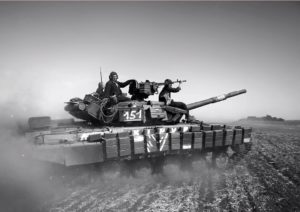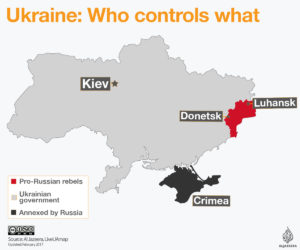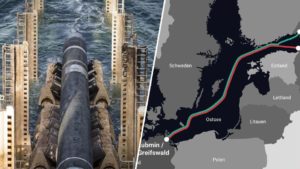By Nikola Mikovic
The West is accusing Russia of preparing to invade Ukraine. Both Moscow and Kiev are flexing muscles and deploying troops waiting for a “major war.” But is the Kremlin really interested in another land grab, or is Russia’s harsh rhetoric just a message to the Western leaders, primarily to the US President Joe Biden?

The roots of the conflict between Russia and Ukraine go back to 2013 and 2014 when the Western-backed opposition overthrew allegedly pro-Russian Ukrainian President Viktor Yanukovych. Moscow responded by incorporating the Crimean Peninsula into the Russian Federation. Soon after the controversial referendum in Crimea in March 2014 (which was recognized solely by Russia), a plebiscite was also held in the energy-rich Donbass region of eastern Ukraine on May 11 2014, but the Kremlin never recognized the independence of the self-proclaimed Donetsk People’s Republic (DPR) and Lugansk People’s Republic (LPR, also called Luhansk). Still, the Kremlin actively supplied arms and volunteers to the Donbass forces, and to this day the region has been in Russia’s sphere of influence. The rest of Ukraine is now in the Western geopolitical orbit, and Kiev is developing close ties with NATO, especially with its second largest member-state – Turkey.

According to reports, since early March Ukraine has been sending tanks, artillery and drones to the turbulent Donbass region. A significant portion of the territory has been under control of the pro-Russian forces since 2014 when the war broke out. In February 2015, representatives of Russia and Ukraine, as well as German and French mediators, signed the so called Minsk-2 ceasefire agreement, which effectively stopped the “active phase” of the conflict. Ever since, the region has been stuck in a positional warfare (a form of warfare conducted along permanent and fortified front lines), but neither Kiev nor the Donbass republics dared to start any major military offensives.
In order to prevent Ukraine from any potential attacks on Russian proxies in the Donbass, at the end of March the Kremlin started building up troops near the border with Ukraine. It was a clear message to the-Western backed former Soviet republic. Moreover, senior Kremlin official, Dmitry Kozak, recently said that the Russian Federation could intervene to defend Russian citizens in the Donbass.
“Everything depends on the scale of the conflagration,” said Kozak, suggesting that pro-Russian forces could hold their own for now against the Ukrainian Army, as they consisted of “battle-hardened units.”
“I support the assessments that also exist inside Ukraine that the beginning of hostilities is the beginning of the end of Ukraine,” Kozak pointed out. In other words, Kozak’s main message is that if Ukraine goes on a full-scale offensive, Russia will intervene by force, which could have severe consequences for the very existence of Ukraine.
The Kremlin has indeed decided to draw a certain red line and see if its opponents will try to cross it. In the past, such threats were voiced mainly by representatives of the DPR and LPR, as well as by individual deputies and senators of the Russian Federation. .In addition, Margarita Simonyan, editor-in-chief of the English-language television news network RT[Russia Today] openly called on the Kremlin to annex the Donbass, and now similar rhetoric comes directly from the Kremlin.
However, if there is a local escalation of the conflict, Russia will likely turn a blind eye, hoping that its proxies on the ground will manage to prevent Ukrainian Armed Forces from capturing any new territories.
After Kozak’s direct threats, Ukraine’s National Security and Defense Council ruled out use of military force for regaining control over non-government controlled areas in Donetsk and Lugansk regions, claiming that Kiev continues to insist on peaceful de-occupation of the regions.
“The liberation of the temporarily occupied territories by force will inevitably lead to the death of a large number of civilians and casualties among the military, which is unacceptable for Ukraine,” General Ruslan Khomchak, chief of the general staff of the Ukrainian Armed Forces said.
It is worth noting, however, that Ukraine’s military announced that it will hold joint military drills with NATO troops later this year. An exact date for the drills, which were described as routine, was not provided. Moreover, Ukrainian leader Volodymyr Zelensky recently said that the US President Joe Biden assured him that “Ukraine will never be left alone against Russia’s aggression”. That, however, does not necessarily mean that Washington will start a war against Russia over Ukraine.

At the Crux of the Matter: the Nord Stream 2 pipeline and Donbass’s Coal Mines
Some analysts have suggested that Russia’s troop build-up may be meant to test the new American administration and its commitment to Ukraine, although it is not improbable that Moscow is sending another type of message to the West. It is no secret that Russia and the West, despite harsh rhetoric, keep doing business as usual whenever they had a common interest. Nowhere is it as obvious as in the case of Russia-to-Germany gas pipeline, Nord Stream 2. In June 2015, an agreement to build Nord Stream 2 was signed between Russia’s state-owned energy giant Gazprom, Royal Dutch Shell, E.ON, an East German utility company, OMV, an Austrian multinational integrated oil and gas company, and Engie, a French multinational electric utility company – even though the United States and the European Union previously imposed sanctions on Moscow for its actions in the Donbass and Crimea. In other words, sanctions-hit Russia signed a multi-billion dollar contract with Western corporations, which is a clear sign that the Russo-Western partnership still lives on.
Once completed, this pipeline is expected to deprive Ukraine of billions of dollars in revenue by allowing Russia to circumvent the country when transferring gas to Europe, which means that the energy-poor Ukraine could soon completely lose its role as the regional gas hub. Thus, it is quite questionable if the Kremlin is really interested in invading such a country. Ninety percent of Ukraine’s coal reserves are located in the Donbass. After Ukraine imposed an economic blockade on the DPR/LPR-controlled territory in 2017, Kiev effectively lost control over the important Donbass mines. Since the mines are located in Donetsk People’s Republic, the authorities of this self-proclaimed entity started exporting coal to Russia, which Kiev then buys from Moscow. In other words, Ukraine is de jure purchasing its own coal from its archenemy. In addition, this year Kiev reportedly resumed electricity imported from Russia, even though such a business was suspended in April 2020.
The Turkish Factor
Ukraine is also purchasing Bayraktar drones from Turkey. The Turkish-made unmanned aerial vehicle proved to be very efficient during the recent war between Azerbaijan and Armenia over Nagorno-Karabakh. It is hardly a coincidence that Zelensky met with Turkish President Recep Tayyip Erdogan in Ankara days after Kozak’s threats. Kiev is undoubtedly interested in developing close ties with Turkey – Russia’s only rival in the Black Sea region. It is worth noting that a day before Zelensky’s meeting with Erdogan, Russian President Putin spoke with Turkish leader over the phone. If the conflict in the Donbass escalates and turns into a large-scale war between Russia and Ukraine, Turkey, as a NATO member-state, could potentially shut down the Bosphorus and Dardanelles straits for Russian ships on their way to Syria. That is why Putin reportedly urged Erdogan to preserve the 1936 Montreux Convention that gives Ankara control over the straits.
Even though Russia and Turkey – partners and rivals at the same time – have a “situational alliance” on many fronts, it is Washington, rather than Ankara, that will have the last say in the ongoing disputes between Russia and Ukraine. The US is using Ukraine as an instrument against Moscow, while the Kremlin’s trump cards in this geopolitical game are the self-proclaimed Donbass republics whose fate will likely depend on the future wider deals between Moscow and Washington over both Ukraine and the Nord Stream 2 pipeline.
Nikola Mikovic is a contributor to CGTN, Global Comment, Byline Times, Informed Comment, and World Geostrategic Insights. He is a goepolitical analyst for KJ Reports, and Global Wonks.
